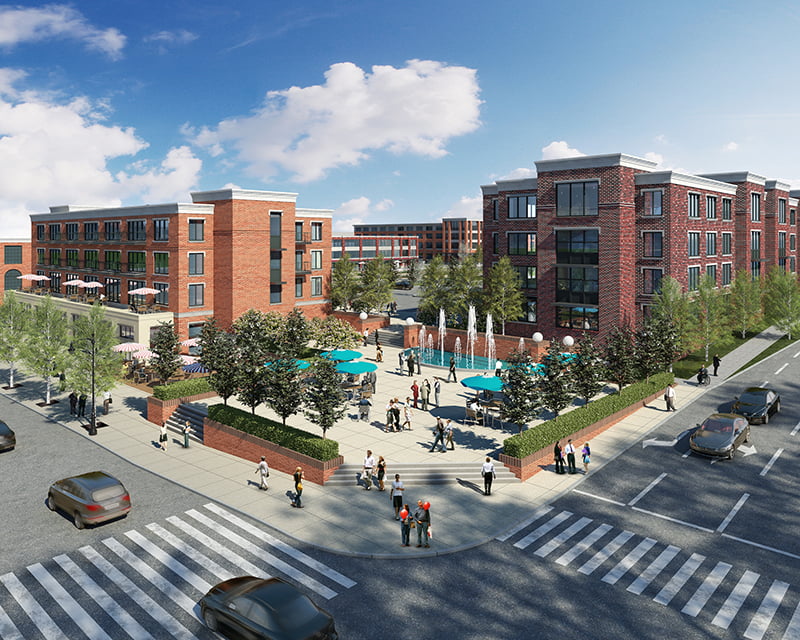
This conceptual drawing of what the development at the old Blackburg Middle School site could look like was a small piece of the proposal that was resubmitted to the town in mid-April. Developers note that the finished product does not always come out looking exactly the same as the renderings, architecturally speaking.
Setting in train a summer of public input, planning commission hearings and town council meetings, a second rezoning proposal of the old Blacksburg Middle School site was submitted recently by Midtown Redevelopment Partners.
Whether the centrally located land, currently 22 acres of field and old trees, is ultimately rezoned or not, the land use that will be determined by citizens, the town and the developer will transform the economic, environmental and social character of the town.
By submitting in mid-April, the developers have submitted their plan as a May 1 submission. The town’s deadlines are typically the first of the month.
As the first step in the public-private project, that, should it move forward, could begin within two years, progress over the next decade and cost between $125 and $150 million, Midtown is first requesting to rezone the property to higher density.
The nine-acre strip fronting Main Street is currently zoned “R-4,” allowing four houses per acre. The proposal seeks to rezone to Downtown Commercial, in order to build a mix of commercial, retail, office, restaurant and residential uses allowing 24 units or 48 bedrooms per acre.
The remaining approximately 12 acres, closer to Willard Street, is proposed to be rezoned Planned Residential, for a mixture of multi-level, multi-family buildings and multi-level townhome buildings that will also allow 24 units or 48 bedrooms per acre.
The group submitted its first original rezoning proposal in October 2017. Following the submission, neighborhood meetings and a planning commission work session were held. The developer has now resubmitted a second rezoning application, exhibits and a colorful pattern book describing the project in rigorous detail and lists proffers the developer is making.
All those and other relevant documents are posted on the Blacksburg website page dedicated to the redevelopment project.
The main changes within the resubmission can be seen by looking at the conceptual plan.
“They have switched the hotel site and the proposed library site,” Blacksburg Town Manager Marc Verniel said. “They have also increased the size of the public plaza that is centered in the front half of the project.”
Overall, the resubmission contains ten changes, many associated with cars: driving them safely, parking them discreetly and screening them from public spaces.
During public comment in the fall, citizens voiced concern around increased traffic, predicting that an enormous development in the center of town would only exacerbate existing struggles faced by the town like limited affordable housing and burdensome traffic.
“A number of the changes do go to address that,” Jim Cowan of Midtown said. “One of the things that we were trying to do is necessarily to limit cars. We know people have cars, but to limit large, surface parking lots. If you want to build something that feels more like a community, or feels like an urban in-fill, with parks and trees-lined streets and such, you don’t want large, surface lots.”
Cowan said the changes minimize the visibility of parking and the need for it.
“We also did a number of things to provide alternative transportation such as a multi-use bike path, a bike lane on Eheart and a very pedestrian and cyclist and non-motorist friendly layout and put a lot of thought into the design.”
Earlier, the developers and the town split the cost of a traffic impact study that examined the Main Street corridor and looked at the effect of the OBMS project, other projections for natural increases in traffic over time and the timing of lights.
Cowan said developers have an obligation that is consistent with the public process.
“Do we generate more or less traffic if people live in an infill development like this with good access to the bus stop and bike paths that connect to downtown and surrounding neighborhoods?” he said. “If we’ve got a walkable connection to the center of town, are we doing more to manage that growth putting it there in the center of town? You do all the things you can to minimize and encourage non motorize transportation.”
So far the submission of applications and development of pattern books have cost at least $1 million.
Recent media coverage intimated that the OBMS developers were finding the re-zoning process burdensome. Both Cowan and Verniel clarifyed that insinuation.
“If this doesn’t articulate in a realistic plan we’re not sure you could go through this exercise again and get any better,” Cowan said. “You reach a point where you have as good a mix of use and design and have done all the things. You’ll never get perfect. You’re never going to get everything that everybody wants,” he said. “But this is as close as you can get. You’re balancing all the different criteria. We feel like we do an awful lot of work.”
Verniel agreed.
“I do not think that the developers are impatient. They submitted a rezoning plan in the fall and held a neighborhood meeting. Town staff also provided them with feedback,” he said. “They decided to pause the process, so that they could make modifications to the plans to respond to the feedback and further discussions with some of the other development partners for the site.”
A page on the town website is dedicated to cataloguing the rezoning process of this highly visible, Main Street property and posts the schedule of upcoming public and town meetings.
It can be found at: www.blacksburg.gov/town-council/meetings/public-hearings/old-blacksburg-middle-school-rezoning.


